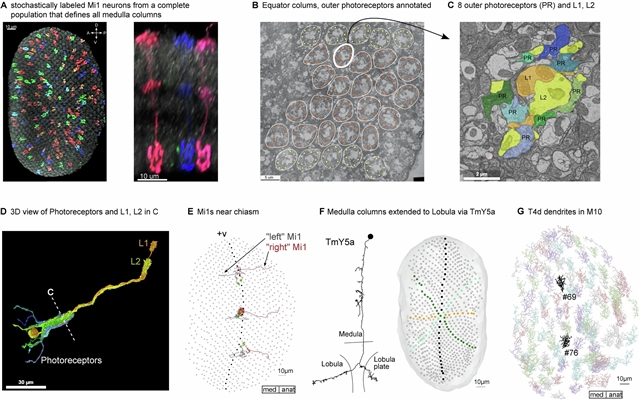
美国HHMI Janelia研究园区Michael B. Reiser课题组在研究中取得进展。他们提出了眼结构决定果蝇运动视觉的神经元功能。相关论文于2025年7月23日发表于国际顶尖学术期刊《自然》杂志上。
在这里,该研究组展示了复眼的组织塑造了整个视野中定向选择神经元偏好方向的系统变化。为了估计整个视野中的首选方向,该研究组在成年苍蝇大脑的电子显微镜体积中重建了数百个T4神经元,并意外地发现了典型的树突。然后,课题组研究人员对整个头部进行了主题化的微型计算机断层扫描,以绘制所有复眼面的观看方向,并发现了视觉空间的非均匀采样,这解释了首选方向的空间变化。他们的研究结果表明,苍蝇的复眼主要决定了定向选择神经元偏好方向的全局组织,揭示了眼睛结构、神经元功能特性和运动控制之间的密切联系。
据悉,许多动物利用视觉来导航它们的环境。自运动在视觉场景中引起的变化模式,称为光流,首先通过定向选择神经元在局部斑块中进行估计。然而,如何组织定向选择性神经元阵列来支持下游电路对光流的自动解码尚不清楚,这些神经元阵列在特定的视网膜位置上以首选方向响应运动。要理解这种全球性的组织,就需要绘制出动物视野中神经元的精细的局部特征。在果蝇中,T4和T5定向选择神经元的不对称树突建立了它们的首选方向,这使得从解剖学上预测定向调谐成为可能。
附:英文原文
Title: Eye structure shapes neuron function in Drosophila motion vision
Author: Zhao, Arthur, Gruntman, Eyal, Nern, Aljoscha, Iyer, Nirmala, Rogers, Edward M., Koskela, Sanna, Siwanowicz, Igor, Dreher, Marisa, Flynn, Miriam A., Laughland, Connor, Ludwig, Henrique, Thomson, Alexander, Moran, Cullen, Gezahegn, Bruck, Bock, Davi D., Reiser, Michael B.
Issue&Volume: 2025-07-23
Abstract: Many animals use vision to navigate their environment. The pattern of changes that self-motion induces in the visual scene, referred to as optic flow1, is first estimated in local patches by directionally selective neurons2,3,4. However, how arrays of directionally selective neurons, each responsive to motion in a preferred direction at specific retinal positions, are organized to support robust decoding of optic flow by downstream circuits is unclear. Understanding this global organization requires mapping fine, local features of neurons across an animal’s field of view3. In Drosophila, the asymmetrical dendrites of the T4 and T5 directionally selective neurons establish their preferred direction, which makes it possible to predict directional tuning from anatomy4,5. Here we show that the organization of the compound eye shapes the systematic variation in the preferred directions of directionally selective neurons across the entire visual field. To estimate the preferred directions across the visual field, we reconstructed hundreds of T4 neurons in an electron-microscopy volume of the full adult fly brain6, and discovered unexpectedly stereotypical dendritic arborizations. We then used whole-head micro-computed-tomography scans to map the viewing directions of all compound eye facets, and found a non-uniform sampling of visual space that explains the spatial variation in preferred directions. Our findings show that the global organization of the directionally selective neurons’ preferred directions is determined mainly by the fly’s compound eye, revealing the intimate connections between eye structure, functional properties of neurons and locomotion control.
DOI: 10.1038/s41586-025-09276-5
Source: https://www.nature.com/articles/s41586-025-09276-5
Nature:《自然》,创刊于1869年。隶属于施普林格·自然出版集团,最新IF:69.504
官方网址:http://www.nature.com/
投稿链接:http://www.nature.com/authors/submit_manuscript.html
